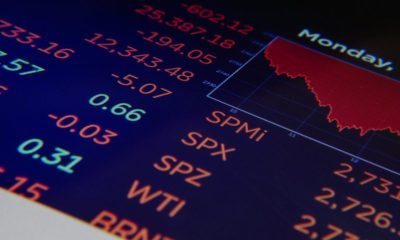Featured
Here’s Why the Stock Market’s Rallying in the Face of Recession
There’s an overwhelming sense of an impending recession, so why have stock markets been in such a strong rally in recent months? One answer could lie in sentiment over fundamentals, with some better-than-expected data coming out. However, there could be more to it, with JP Morgan estimating that “the uptick in risk appetite is justified on a more fundamental basis.” So what’s going on?

The European and US stock markets are enjoying a mini-rally that began in mid-June. Some indices such as the Spanish Ibex 35 have registered an almost 10% increase since then, leading to a streak of eleven bullish sessions, the second longest of the century. For their part, bonds have also traded with some relief recently (the price rises and interest falls).
Nevertheless, many investors wonder what is happening in the markets. The war in Ukraine continues, inflation remains at historically high levels, and central banks are raising interest rates at the fastest pace in decades. This combination should be lethal for risk assets.
Keep up with the latest market predictions and analysis with our free investment news app.
Market Drivers: Fundamentals vs. Sentiment
While stocks follow macroeconomic trends in the long term, in the short term, markets generally move to the beat of whatever drum bangs the loudest that day.
Since the beginning of the war in Ukraine, there have been moments of great stress and uncertainty. Not only because of the war itself and bad industrial production and retail sales data but also because the rise in inflation seemed to have no ceiling, forcing the central banks to tighten their monetary policy sine die despite the deterioration of the economy.
However, this narrative has changed slightly in a matter of weeks, encouraging markets and risk assets (although stocks are now struggling to continue to fuel the rally). This can be seen in the latest Bank of America Merrill Lynch manager survey, where a single sentence from one of economist reads: “The sentiment is still bearish, but it is no longer apocalyptically bearish thanks to heightened hopes that the impact of inflation and interest rates will end in the coming quarters.”
That explains why market participants have gone on a spending spree, despite the deflation storm brewing on the horizon.
Oil Crash
How did we get to this less malignant scenario? On the one hand, the price of raw materials has fallen sharply, including oil, while some ‘macro’ indicators seem to be holding up more solidly (at least in the summer). The central bank’s own move in raising rates rapidly has helped cap the rally in commodities, creating lower demand expectations.
In addition, the peak of inflation seems to be much closer in Europe, while it is already behind us in the US where producer and import prices are finally beginning to moderate as the logjam in supply chains unravels.
All of this has been like rain in May for risk assets. However, experts continue to warn that just as sentiment has improved rapidly in those weeks, it could deteriorate in the blink of an eye if the winds shifts direction.
But Still, Shouldn’t Stocks and Bonds Be Suffering?
Schroders has published a podcast entitled ‘Why the Markets Are Rallying While Interest Rates Are Rising’ in which they try to solve this mystery. In principle, higher interest rates directly affect future profits and the price of outstanding debt, so in an environment like the current one, both stocks and bonds should suffer falls.
Schroders experts explain that this rally in risk assets is due to recent sentiment changes. Until just mid-June, all manager survey data was wildly negative. Now, the situation seems less bad. One could even say that the hawkish tone (expectations of interest rate hikes) of the central bank has left its peak behind.
However, it must be clear that the inflation problem is not over yet. The data that’s coming in is welcome, but pricing in rate cuts like the market is doing for 2023 is still too early. Nonetheless, all of this is benefiting risk asset prices. However, we are going to continue to see high volatility “.
JP Morgan Says Fundamentals Back the Rally Up
On the other hand, JP Morgan argues in its weekly market outlook that “the uptick in risk appetite is justified on a more fundamental basis.” The firm does note, however, that “although many have attributed only the recent improvement in market sentiment to technical factors, short positions or ‘bear market recovery’, with moves magnified by already low liquidity and positioning Splitting the growth scenarios into a decision tree, as our economists have done, there is one branch expressing the risk of an impending recession.”
They also note that “another branch delays the recession to the year 2023 or 2024, as well as a soft landing scenario,” and that their view holds that “the probability of the ‘soft landing’ scenario has increased after the weaker-than-expected CPI/PPI reports in July.”
How Long Will the Rally Last?
The Bank of America Merrill Lynch believes that new inflation-related indicators have softened the expectations of interest rate hikes by the Fed. According to the bank, these expectations are causing the price change in stocks and bonds.
But on the question of whether this rally will continue, BofAML experts believe it has little choice: “We think unlikely. The main prerequisite for a sustained equity market rally is that the macroeconomic cycle finds a bottom and a new acceleration in growth momentum, but the headwinds to growth remain considerable.”
The bank also speaks of several well-defined obstacles:
- The tightening of bank lending conditions in the euro area points to further weakness in the euro area PMI.
- Low rates of Russian gas supply through the Nord Stream pipeline increase the risk of gas rationing during the winter, which, according to our economists, would push the euro area into recession.
- It is expected that the high renewal of inventories weighed down growth in the US until the end of the year; d) The impact of the Fed’s aggressive tightening on the US credit cycle has yet to be fully felt. As a consequence, we see a further decline for the Eurozone and US Composite PMIs.”
For the rally will continue, a series of requirements would have to be met that seem very unlikely and complicated today.
BofAML experts list these as:
- A ceasefire in the Russia/Ukraine conflict would reduce the risks of gas supply for Europe and lower commodity prices, removing some of the pressure central banks have to further tighten policy in response to high inflation.
- A sharp acceleration in China’s growth momentum, which could rescue the cycle.
- A stronger-than-expected resilience in the US economy, at least as suggested by the brilliant July payrolls report, when more than 500,000 jobs were created.
All in all, the baseline scenario speaks of economic weakness in the eurozone, high inflation for a while (although it has already peaked, inflation will continue to be above 2% for months or years) in advanced countries, and relatively low economic growth in China.
All this should end the rally that the stock markets have experienced in recent weeks and bring investors back to reality sooner rather than later.
__
(Featured image by Ahmer Kalam via Unsplash)
This article may include forward-looking statements. These forward-looking statements generally are identified by the words “believe,” “project,” “estimate,” “become,” “plan,” “will,” and similar expressions. These forward-looking statements involve known and unknown risks as well as uncertainties, including those discussed in the following cautionary statements and elsewhere in this article and on this site. Although the Company may believe that its expectations are based on reasonable assumptions, the actual results that the Company may achieve may differ materially from any forward-looking statements, which reflect the opinions of the management of the Company only as of the date hereof. Additionally, please make sure to read these important disclosures.
First published in El Economista, a third-party contributor translated and adapted the article from the original. In case of discrepancy, the original will prevail.
Although we made reasonable efforts to provide accurate translations, some parts may be incorrect. Born2Invest assumes no responsibility for errors, omissions or ambiguities in the translations provided on this website. Any person or entity relying on translated content does so at their own risk. Born2Invest is not responsible for losses caused by such reliance on the accuracy or reliability of translated information. If you wish to report an error or inaccuracy in the translation, we encourage you to contact us.

-

 Cannabis1 week ago
Cannabis1 week agoMedical Cannabis vs Street Weed: Why Therapy Makes More Sense in 2025
-

 Markets2 days ago
Markets2 days agoGold, Liquidity, and Market Complacency Heading Into 2026
-

 Impact Investing1 week ago
Impact Investing1 week agoCOP30: Fragmented Climate Politics, Multi-Speed Transition, and Emerging Investment Opportunities
-

 Biotech2 days ago
Biotech2 days agoSalmoss Biotech: Turning Salmon Waste Into Breakthroughs in Regenerative Medicine

























